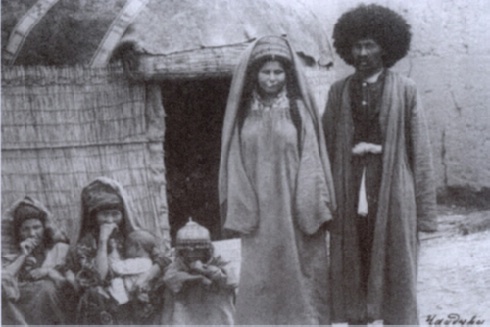Mashhad the Center of Khorasan
Nāder Shāh Afshār (1736-1747)
It is most likely that the Jews left Mashhad because of the growing religious fanaticism of the Moslem inhabitants. Wishing to develop the town's trade and crafts in the 1730s and in the 1740s, Nāder Shāh Afshār (1736-1747) again brought the Jews of Qazvin and other Iranian towns to Mashhad. This was opposed by the religious establishment of Iran, but the ruler prevailed.(2) The largest number of Jews came from Gilan province, and so the Gilaki dialect of Persian became the principal language of Mashhad Jews. (3) At the same time there was also another dialect spoken. It was Yazd dialect, brought here by a part of the Jewish immigrants.(4) After resettlement, many Jews started trading with Turkmenian tribes,(5) the ones living in the south of Turkmenia - Tekkes, Sālors and Saryks.
Joseph Wolff, an English Protestant missionary of Jewish origin, who settled in Mashhad in 1831, claimed the local Jews even went to Russia for commerce with their caravans.(6) Lieutenant Colonel Johann Blaramberg, a Holland-born employee of the Russian government who visited Mashhad in 1838 as a member of a Russian delegation, pointed out that the main occupation of local Jews was trading in turquoise, which they themselves polished and set.
Their jewelry was exported to Russia via Bukhara, and, to a lesser cxtent, to India.(7) Another English Protestant missionary of Jewish origin, Jacob Samuel, who visited Persia in 1836, wrote about a large number of Jews in Turkmenia (of whom he had heard),(8) obviously referring to the ones from Mashhad. The economic status of the Mashhadi Jews gradually improved, which drew Jews of other Iranian towns to settle there.(9)
Statistic information about Mashhadi Jews are somewhat contradictory. In 1807, the French officer M. Truilhier found only about 100 Jewish families in Mashhad, (10) while Georg Meyendorf, a Russian officer of German origin, learned from Jews of Bukhara that in 1821, the Mashhadi Jews had owned 300 houses. (11) Johann Blaramberg testified that in 1838, about 400 Jews lived there,(12) probably meaning the number of families. If we assume that, on average, five people lived in a Mashhadi house, similar to other homes in Central Asia, (13) the total number of Jews must have been two thousand. This is how Joseph Wolff estimated their population when he visited Mashhad again in 1843-1844. (14) Taking into consideration what happened to them in 1839 (see below) the statistics provided by Joseph Wolff seem to be somewhat overstated at the time of his second visit to Mashhad and probably his estimation corresponds more to the late 1830s. Against this background, the data provided by the following colonels seem to be greatly understated: the English colonel Arthur Conolly counted only 100 houses of Mashhadi Jews in 1831, (15) and the French colonel Joseph Ferrier mentioned that in 1845 there were only 600 Jews there.(16)The 19th Century
Djedid Jews of Mashhad
In Afghan towns, Jews of Mashhad openly returned to Judaism because the dominant Islamic doctrine there was that of the Sunnis, and Shi'ites were considered heretics. Herat became the largest center of concentration of Mashhadi Jews outside of their native town. They identified themselves with the local Jewish community, which they outnumbered by far.(30) Consequently, most probably, by the last yuarter of the 19th century, originally Herati Jews were assimilated by better educated and wealthier Mashhadi Jews who took the lead of the Jewish community in Herat. With that, because of their new citizenship and place of residence they were called "either Afghani and Herati Djedids or Afghani and Herati Jews" in pre-Revolutionary Russia while other Jews from Mashhad received the name "Mashhadi Djedids". Accordingly, this article will use such names, despite the above-described definition of the term "Djedids," to include not all of the descendants of Mashhadi Jews who convcrted to Islam, but only those who openly or secretly returned to Judaism, preserving by that their membership in the Jewish community and not assimilating into the lslamic world. The descendants of the newly--converted Mashhadi Jews called themselves Djedids in their official addresses to the Russian authorities instead of calling themselves Jews. The reasons for that will be revealed below. In Mashhad they also were officially called Djedids. And in other Iranian cities they called themselves Moslems from Mashhad in order to hide their Jewish origin.
"Mashhadi"
The Jews of Balkh
Apart from the Jews of Herat, the only significant Jewish community in the territory of modern Afghanistan during the 19th century was in Balkh. Michael Zand considers the Jews of Balkh to be a part of the Bukharan Jewish ethnos whose dialect they spoke. (31) In other cities of Afghanistan the Jewish population in the 19th century was insignificant and consisted basically of emigrants from Iran and Bukhara. Despite the lack of indigenous Jews at the end of the 19th century, during the 1920's and the 1930's the Jews of Afghanistan were a united political community viewed by Itzhak Bezalel as Afghani Jewry. (32) This was most likely a consequence of Afghanistan's self-isolation during these years. In Eretz-Israel this political association has, over time, led to a change of self-identification by natives of Herat. Those who had not joined the Mashhadi community consider themselves Herati, or Afghani Jews.
(ibid., p. 1-7)



